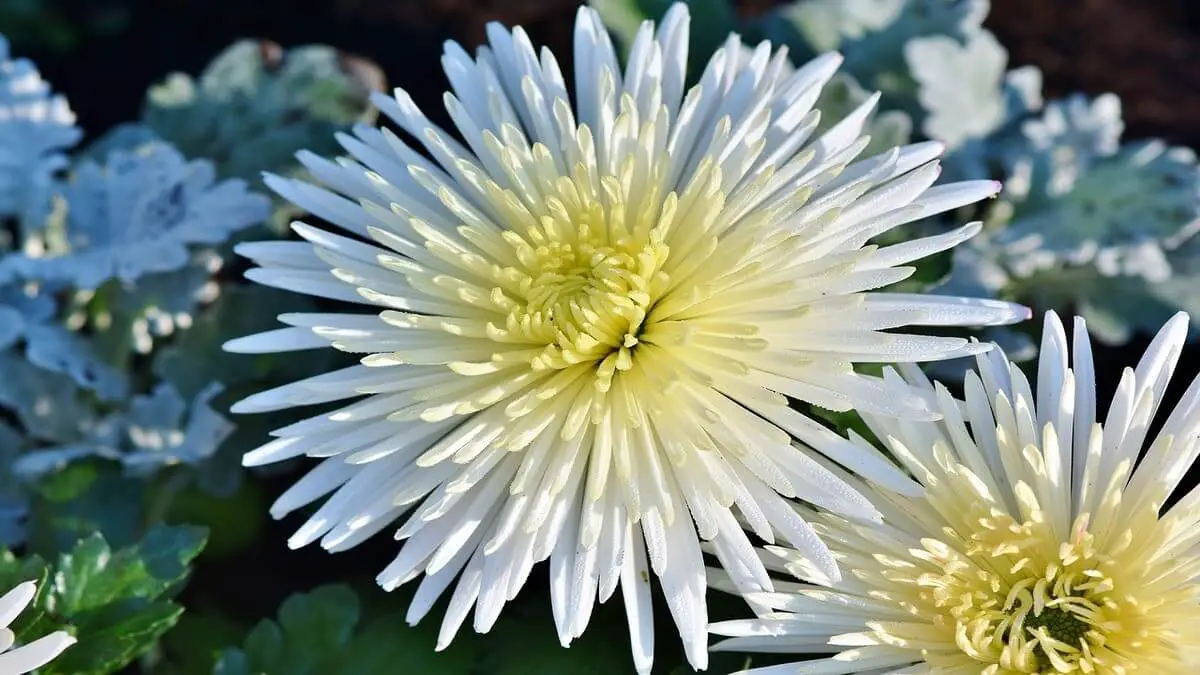White Aster and its Varieties
The white aster belongs to the Asteraceae family. This family consists of many flowering plants including sunflower, daisy, and dahlia. In fact, this family has more than 32,000 species. They are classified under 1,900 genera over 13 subfamilies. This family is expected to grow further in the future.
There are various varieties of aster flowers in various shades. In this article, we primarily focus on the white aster variety and a couple of its cousin varieties. You can use most of them as ornamental plants in your gardens, backyards, woodlands, rockeries, and so on.
White aster flowers generally have a dense head with tiny florets. Lengthy white rays sprout out surrounding these central heads. Some of its varieties are discussed below:
Table of Contents
Snowbank white Aster
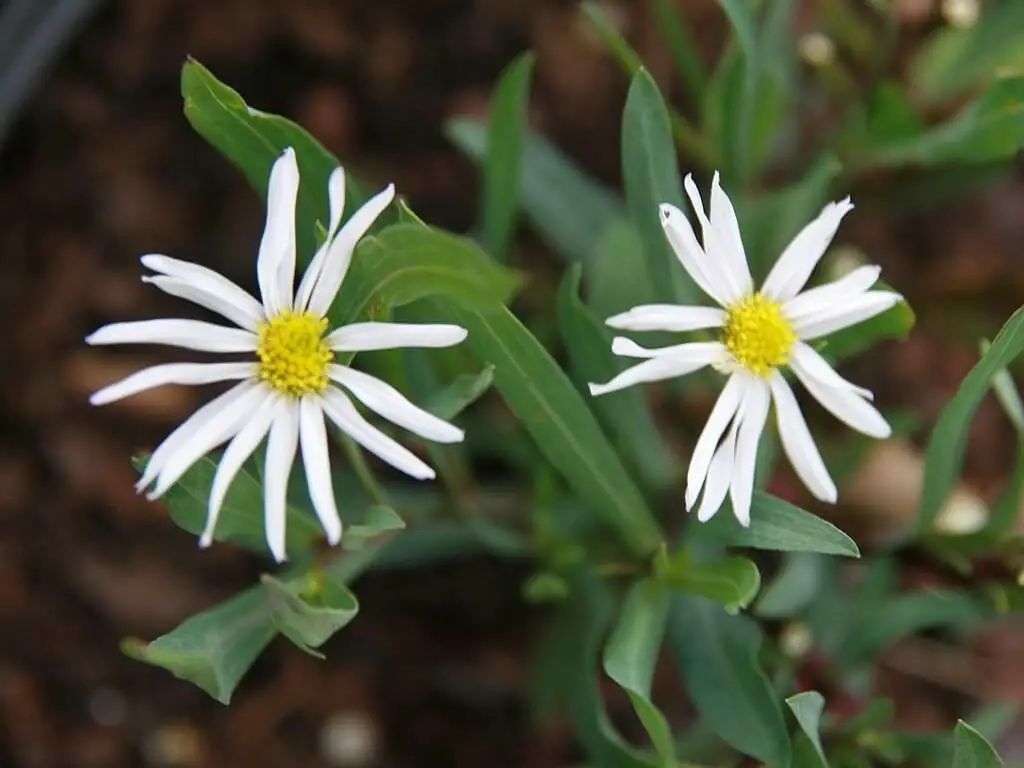
Photo by David J. Stang (Wikimedia Commons) (CC BY-SA 4.0)
This variety of white aster (Boltonia asteroids) is commonly called false aster or false chamomile. Snowbank is native to the USA. It is a rhizomatous perennial plant. USDA recommends zone 4 to 9 to grow these types of plants. Snowbank usually prefers sunny locations with moist and well-draining soil. It also can tolerate some irregularities like salt, over-saturation, or dense clay.
The ‘true species’ can grow almost up to 9 feet. But this ‘false’ variety, can grow only up to 3-4 feet tall upon maturity.
Its panicles are usually spacy and heavily loaded with 3/4-inch flowers. Generally, these flowers have a yellow central disk. White rays sprout out surrounding this head. Sometimes, these rays also have pink tinges.
You can also purchase good-quality seeds online for propagation. The blooming season of these plants is usually from summer to fall. You can mass plant them in drifts or use them for dense hedging.
Large Leaved Wood Aster
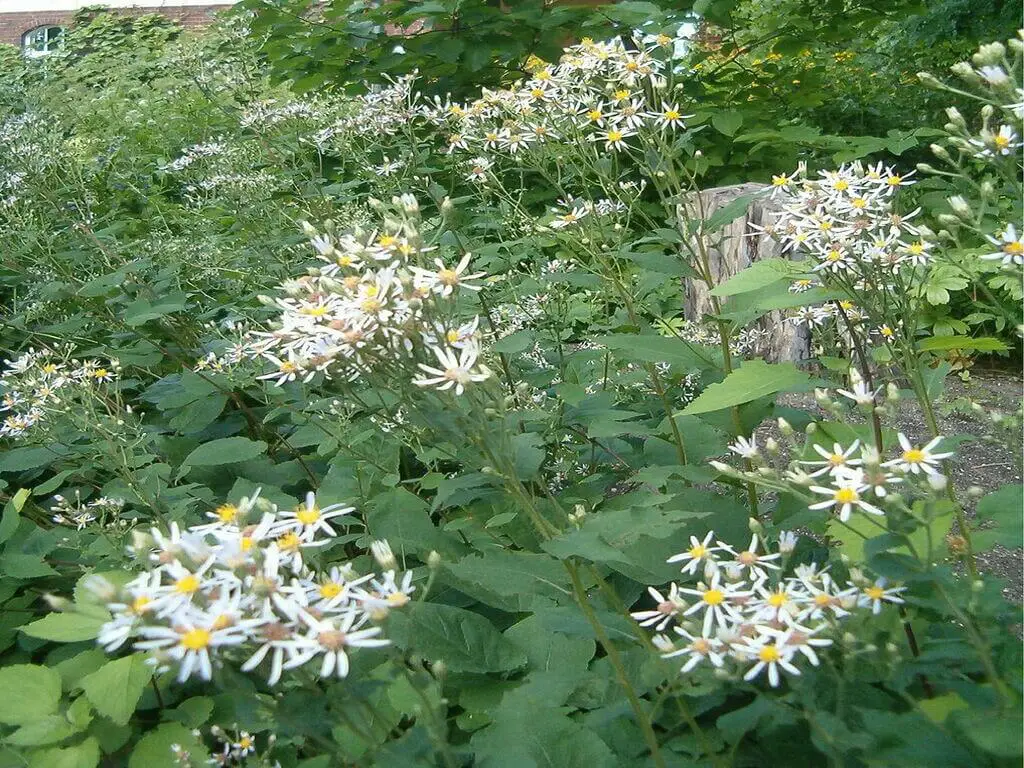
Photo by BotBln (Wikimedia Commons) (CC BY-SA 3.0)
Typically, the Large-leaved wood-aster (Eurybia macrophylla) is a perennial plant. Spreading from rhizomatous, these plants grow 2-4′ tall. Sprouting from yellow central disks, the rays are pale lavender in color. Sometimes they appear in white color also. The leaves are pale green in color.
Large-leaved wood-aster plants prefer to grow in shady areas with medium moist soils. These plants grow quickly. In fact, this fast-growing habit enables them to form thick ground covers.
In addition, the leaves of these plants are edible. Hence, you can consume them freely as needed.
Snow Flurry White Heath

Photo by davecz2 (Wikimedia Commons) (CC BY-SA 4.0)
The snow flurry (Symphyotrichum ericoides) is a perennial plant, native to the USA. It also is a ground-covering plant. USDA recommends Zones 3 – 9 to grow this cultivar.
This Plant grows 4-6 inches tall. It grows well in sunny locations with well-draining soil. Comparatively, this cultivar variety requires minimal watering. Hence, this variety is suited for xeriscaping process.
It has 1/2 inch tiny flowers. They sprout slender rays around a yellow central head. These plants generally blossom from late summer to fall. They can also resist harmful mildews, tolerate poor-quality soil, drought, etc.
Bridal Veili is a cousin variety of this cultivar. It can grow up to 2 feet tall. Normally, Bridal Veili grows ‘arching to ground’ style, with a greater density of flowers and leaves. It exhibits attractive looks for rocky gardens. You can purchase seeds for propagation online.
White Swan New York
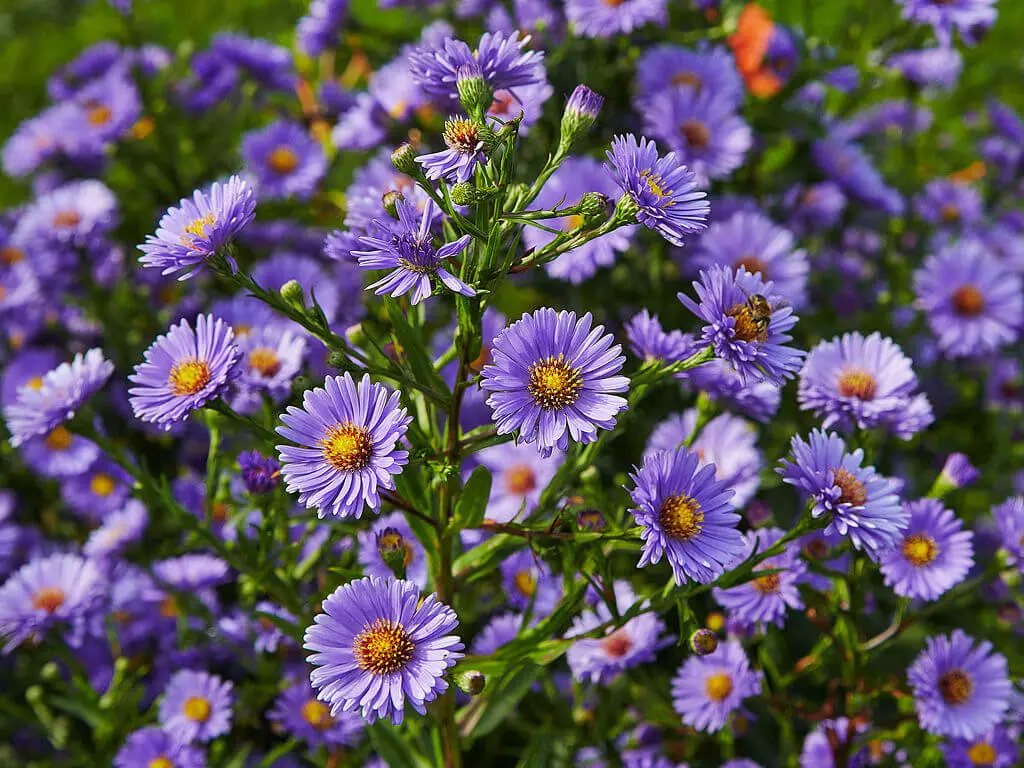
Photo by C T Johansson (Wikimedia Commons) (CC BY 3.0)
The white swan cultivar (Symphyotrichum novi-belgii, aka Michaelmas daisy) is a perennial Plant. It is a US native plant. This plant usually prefers to grow in full sunlight. It also needs moist, well-drain soil to grow healthy. USDA recommends Zones 4 – 8 to grow these plants.
Growing about 1 – 3 feet tall, these plants bloom from summer to fall. The beautiful white flowers measure about 1.5 inches across. They have a bold yellow center disk. Emerging out of this disk, the rays look similar to those of daisy flowers. These flowers grow in abundance over foliage clumps.
You can propagate them using seeds. But make sure the seeds are sown with adequate distance. This arrangement facilitates air circulation around the plants. This helps to prevent common plant diseases like powdery mildew.
Colour Carpet
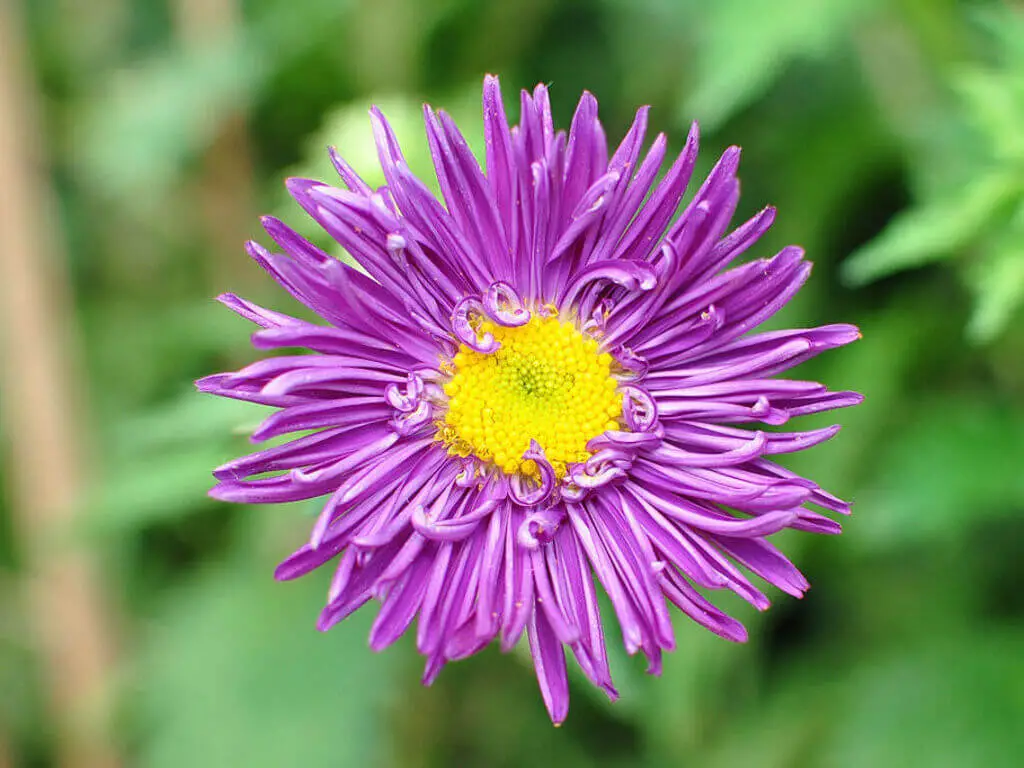
Photo by Joe Ravi (Wikimedia Commons) (CC BY-SA 3.0)
The Colour Carpet White aster (Callistephus chinensis) is also called China Aster. USDA recommends zones 2-11 to grow this variety. These plants prefer to grow in fully sunny to partially shaded areas. Make sure to plant them in fertile, moist, and well-drained soil.
There are different varieties of these plants. ‘Dwarf Colour Carpet White’ cultivar is one of the most famous varieties among them. Generally, this plant grows 8- 10 inches tall. Its flower heads measure 3 inches across. Sometimes these flowers resemble chrysanthemum (mums or chrysanths) flowers. These plants normally blossom from late summer to fall. For propagation purposes, you can buy seeds of these variants online.
These plants can beautify the garden beds and borders. You can also interplant them with other ornamental species. But make sure to select plants that have similar growth characteristics. They can be an excellent eye-catching addition to your container gardens too.
With shallow roots, these plants rarely become pot bound. In fact, the pots may dry quicker than the earth surface. Hence, be vigilant on watering.
Flat-Topped White Aster
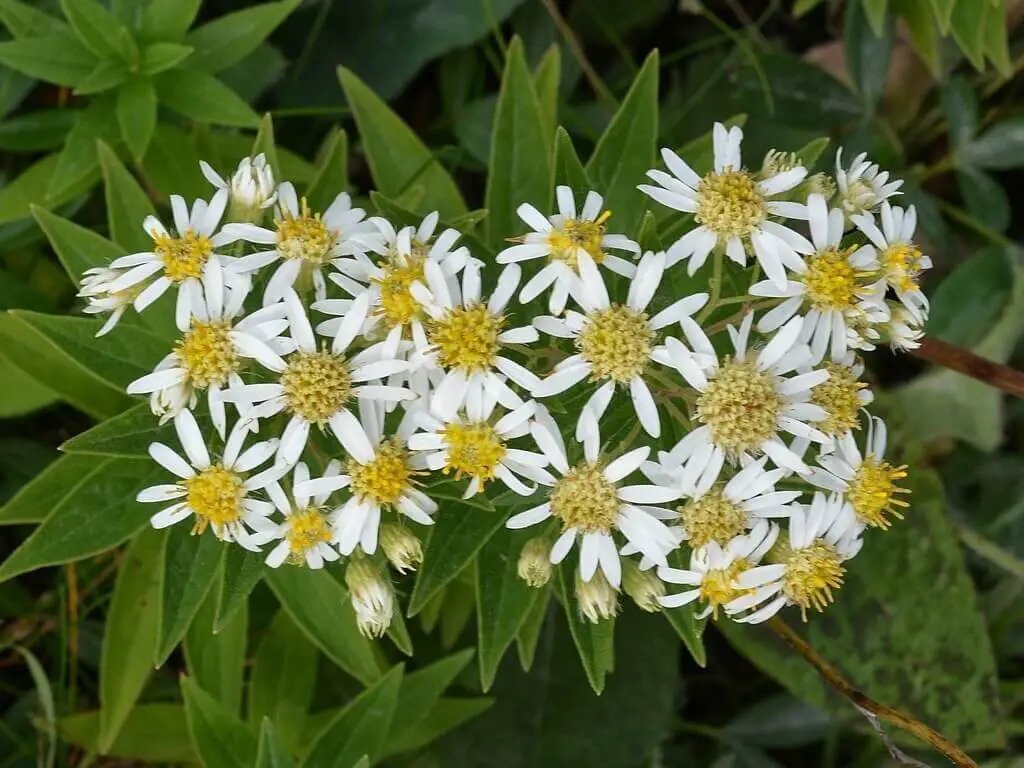
Photo by Ryan Hodnett (Wikimedia Commons) (CC BY-SA 4.0)
The flat-topped aster (Doellingeria umbellate) is also called tall white aster. This is a USA native perennial variety. USDA recommends Zones 3-8 to grow these plants. It prefers to grow in fully sunny to partially shaded areas. Make sure to plant them in mildly acidic, moist, and well-drained soil.
The flat-topped aster plant has a bushy appearance. It grows to expand both vertically and horizontally (mounding plant). These types of plants can normally grow 2-5 feet tall. They also have yellow-centered flowers measuring 1/2-inch across. This variety of plants normally bloom from midsummer to fall
Typically, these plants can beautify your spaces with their bushy appearance and attractive white flowers. Many garden centers and online stores sell the seeds for propagation.
Flax leaved white Aster

Photo by Fritzflohrreynolds (Wikimedia Commons) (CC BY-SA 3.0)
Flax-leaved stiff aster (Ionactis linariifolia) is a North American species plant from the daisy family. It also has many other names including Flax-leaf White-top, Bristly Aster, and Ankle Aster. This perennial herb prefers to grow in full sun to partially shaded areas.
Typically, Flax leaved stiff aster plants grow about 28 inches (70cm) in height. Growing about 1.6 inches (4 cm) long, the narrow leaves are green in color.
Normally, these plants bloom in the august- September months. In flat-topped arrays, these plants produce several flower heads. Flowers mostly have yellow-colored central disks.
You can use these plants to decorate edges of patios, dry gardens, sandy meadows, or gravelly soils. They never fail to provide attractive looks to your spaces.
White Wood Aster
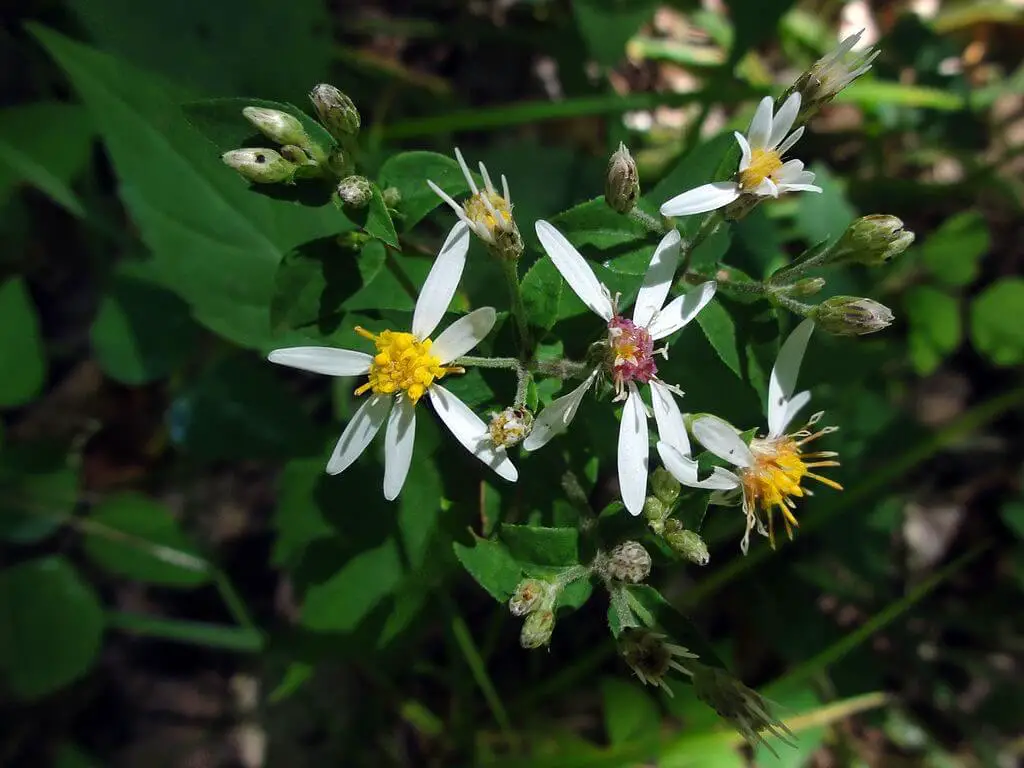
Photo by R. A. Nonenmacher (Wikimedia Commons) (CC BY-SA 4.0)
The White Wood Aster (Eurybia divaricate) is a perennial plant, native to the USA. USDA recommends Zones 3-8 to grow these plants. Generally, White Wood Aster prefers to grow in partially to fully shaded areas. These plants thrive well in moist and well-drained soils. However, these drought-tolerant plants can survive in average quality or dry soils also.
Normally, this variety grows only up to 2 and a half feet. Hence, it is considered a dwarf variety.
These plants bloom in the summer and fall. Measuring across an inch, the flowers have star-like rays sprouting out of the yellow centers. With age, these rays tend to turn red.
This variety of plants grow in a mounding fashion. They expand vertically and horizontally to provide a bush-like appearance. These plants usually require ample air circulation for thriving healthily.
Frost White Aster
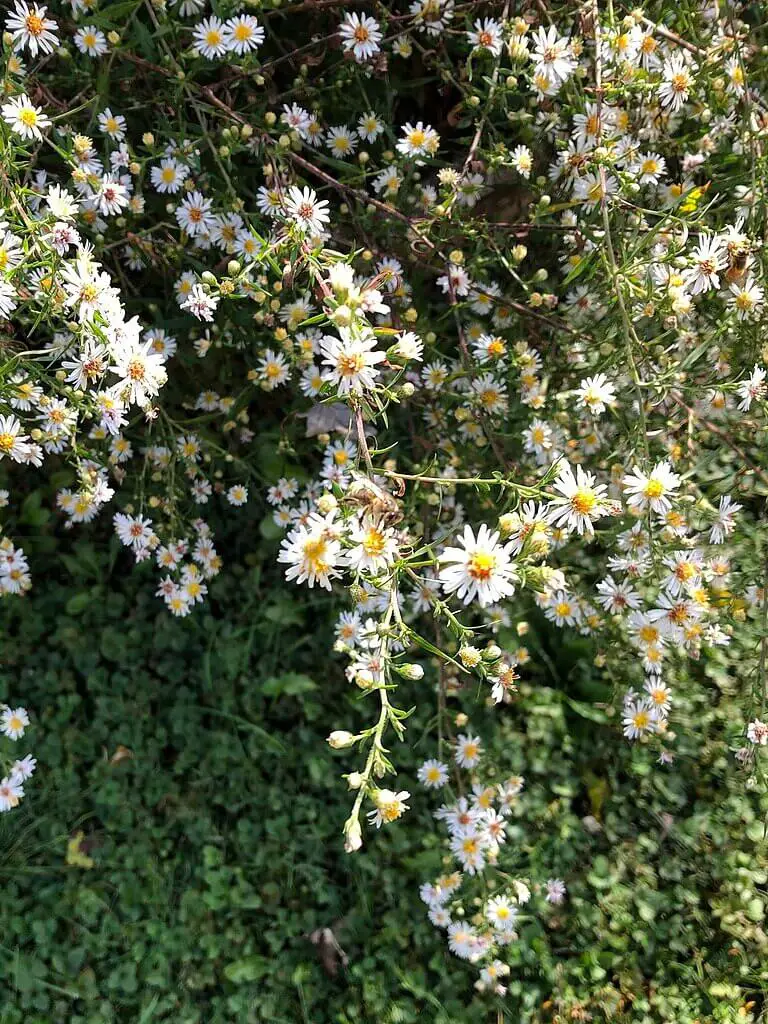
Photo by Elizabeth Ballard (Wikimedia Commons) (CC BY-SA 4.0)
The frost aster (Symphyotrichum pilosum) is a perennial plant, native to the US. USDA recommends Zones 4 to 8 to grow these plants. It prefers to grow in partially shaded to full sunny areas to grow. It also requires moist, well-drained soil to grow healthy. Normally, these plants can tolerate some over-saturation.
Typically, these plants grow in mounding fashions (expanding vertically and horizontally) and provide bushy looks. Growing about 4-5 feet tall, these plants have hairy leaves and stems.
Like most other varieties, these plants bloom in summer and fall. Usually, the flowers measure 3/4-inch across. The slender rays of flowers sprout out from a central yellow disk.
You can mass plant these herbs in spaces like meadows. They enhance the looks of your spaces by providing striking looks. This variety naturalizes quickly in many types of soils. Hence, some people consider it a weed.
Lady in Black Calico
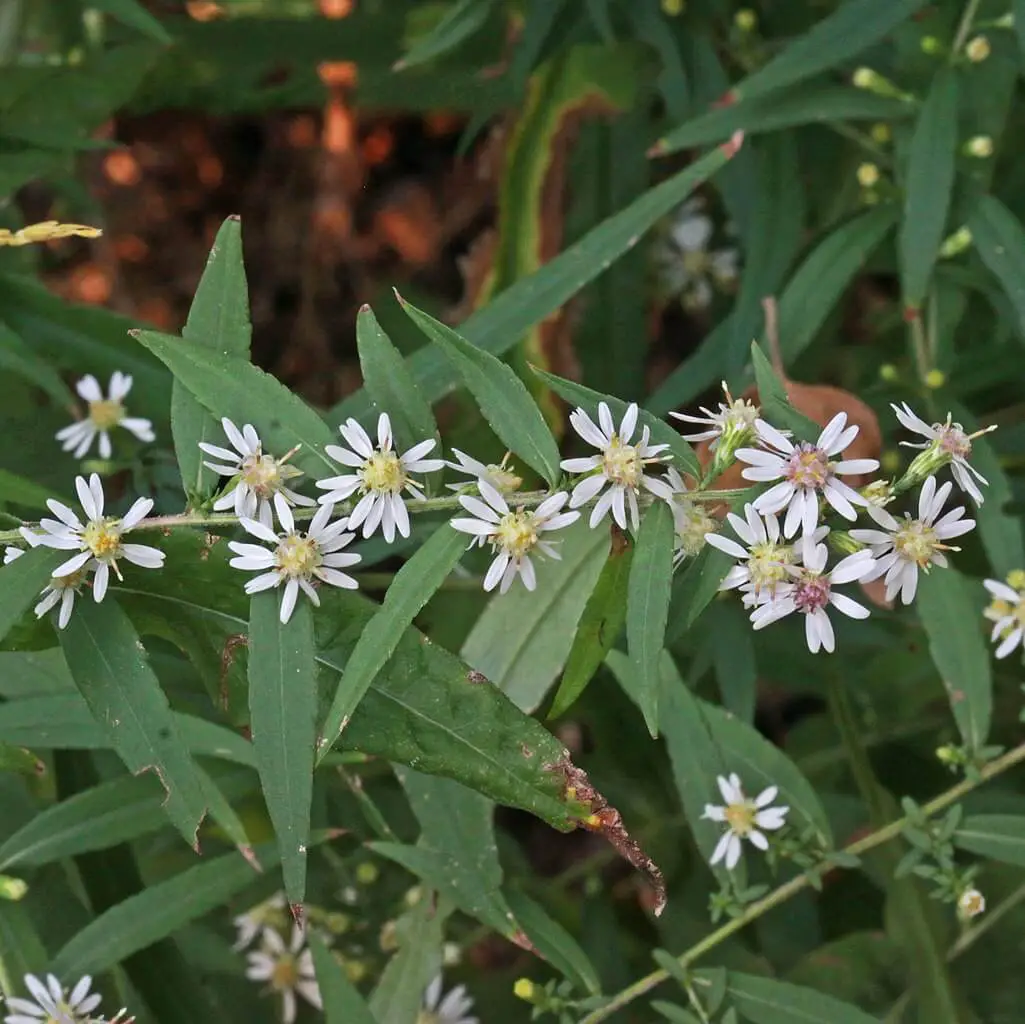
Photo by andrey_zharkikh (Wikimedia Commons) (CC BY 4.0)
The white-woodland aster (Symphyotrichum lateriflorum) belongs to calico variety. It is also called Lady in Black calico. It is a perennial plant having native roots in the US. USDA recommends Hardiness Zones 3-8 to grow these plants. It grows well in partially shaded locations to full sunny areas. These plants prefer moist and well-draining soil to grow. This plant can tolerate some over-saturation.
These plants prefer to grow in fully sunny to partially shaded locations that have moist and well-draining soils. However, they can tolerate some over-saturation also.
Like some other varieties, this variety also grows in a mounding fashion. These plants grow about 3-4 feet tall.
Typically, the blooming season is summer and fall. The flowers usually grow in clusters along the stem sides. They measure about 1/2-inch across. Usually, the white rays sprout out of thick red- or purple-colored central disks. With age, the foliage turns deep purple.
You can also buy the seeds of this plant online for any purpose including propagation.
Alba Stokes
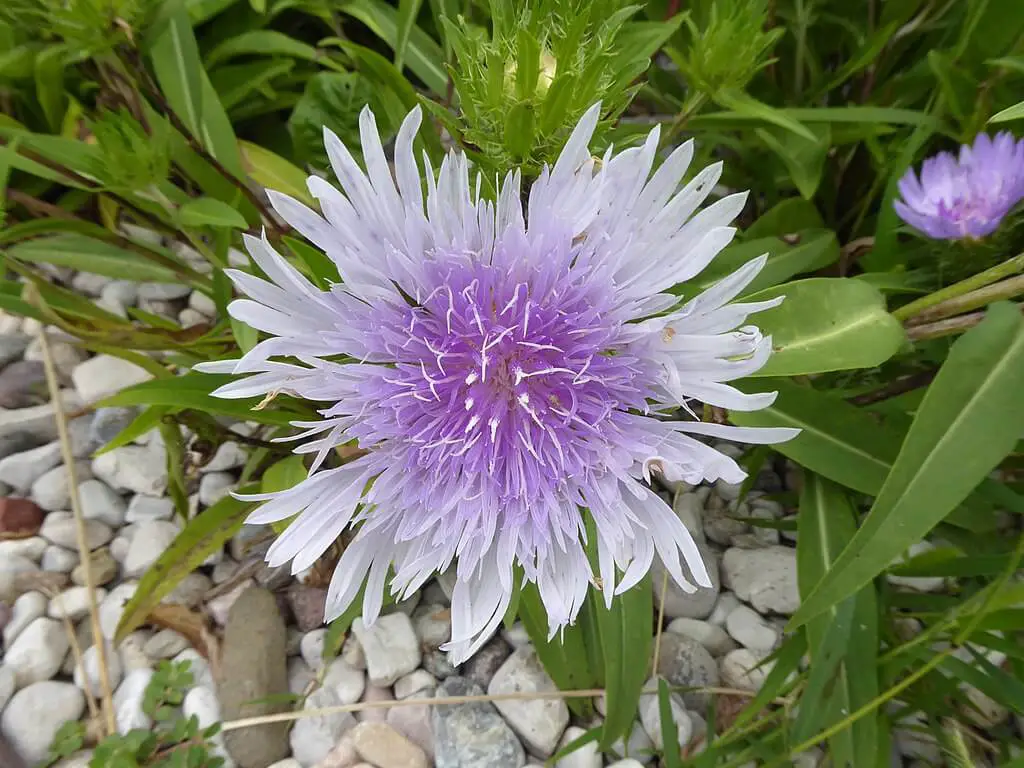
Photo by Syrio (Wikimedia Commons) (CC BY-SA 4.0)
Alba Stokes aster (Stokesia laevis) is a US native perennial plant. USDA recommends Zones 5 – 9 to grow these plants.
Typically, Alba Stokes grows well in sunny locations that have well-draining soils. It can also thrive in several types of soils. Naturally, this plant has drought-resistant capabilities and can repel deer.
If you live in colder areas, make sure to mulch these plants in winter. You can use shredded bark, bark chips, evergreen boughs, straw, and also other coarse-textured loosely packed organic materials for mulching.
These varieties develop 2.5-inch individual flowers on stems. The appearance of these flowers is similar to Centaurea cyanus (bachelor’s button) flowers.
Normally, Alba Stokes grows 1 – 1.5 feet tall. Hence, they fit perfectly for small spaces, particularly indoors.
These plants bloom from spring to summer. If you pluck the mature blooms, the plant delays its seed production and spends its energy to produce more fresh flowers. This technique is called ‘diligent deadheading’.
Panicled White Aster
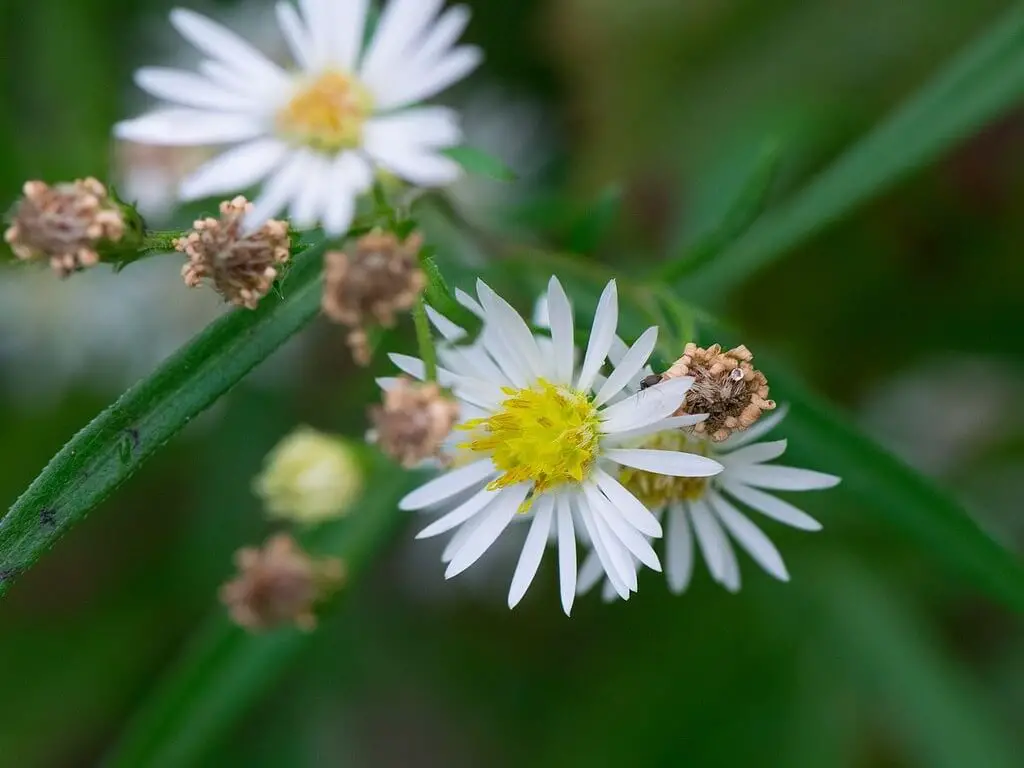
Photo by Joshua Mayer (Wikimedia Commons) (CC BY-SA 2.0)
White Panicled (Symphyotrichum lanceolatum) is a perennial plant. It is native to the USA. USDA recommends Zones 3 – 9 for growing these types of plants. It prefers to grow in partially shaded areas and sunny areas. It thrives well in slightly acidic, moist, and well-draining soils.
Normally, these herbs grow 1.5 m (5 feet) tall. Under ideal conditions, they may reach up to 2 meters (6.6 feet) also. These plants usually spread through rhizomes.
The leaves are attached to the petioles and sheath them at their bases. These leaves are smaller at the top and larger (about 15 cm) near the bottom. Sometimes, the larger leaves (at the bottom) have toothed edges.
Usually, the flowers form in clusters and measure about 1/2 to 3/4 inches across. They contain about 16 to 50 ray florets that are about 3 to 14 millimeters long. Typically, the rays are white in color. Sometimes, they may have blue to violet colors. While blooming, the central disk is yellow in color. But it may turn red or purple with age.
These plants usually bloom from late summer to fall. Plant these cultivars in abundant spaces. They are habited to grow vigorously.
Other Varieties

There are also other two famous varieties called Arrowleaf, (Symphyotrichum urophyllum) and Arrowleaf (Symphyotrichum sagittifolium). They both have similar characteristics and often referred to interchangeably.
They are US native perennial plants. USDA recommends Zones 3- 9 to grow them. Typically, they grow well in partially shaded to sunny locations that have well-draining soils.
Normally, these plants grow 1 – 4 feet tall. They have cone-shaped clusters that carry 1/2-inch blooms. Mostly, the rays are white. Sometimes they can show a light blue shade also. The flowers have yellow central disks that tend to turn red with age. You can distinguish them easily, as these plants have heart-shaped basal leaves.
These plants bloom from late summer to fall. You can grow them in your backyards or woodlands. They can decorate your outer spaces beautifully.
White Aster – Common Characteristics
The White aster and its cousin varieties are perennial species. They can grow vigorously through their extensive rooting systems. These plants are well known for their self-sowing capabilities. Hence, once you plant them along a walkway or on meadows, you can expect them to grow prolifically in most cases.
Generally, White Aster and its cousin varieties are energic plants. While planting, make sure to space them apart. This facilitates the airflow around the plants and prevents many common plant diseases.
These plants can attract beneficial insects and backyard birds. You can enjoy your spare time also by looking at and listening to the beautiful birds.
The White aster and its cousin varieties provide a beautiful white view during day time. They also shimmer in the cool moonlight. At any given time, just enjoy the serene ambiance and beautiful looks provided by these plants. They are enough to relax the heated minds!
Similar Posts
Growing and Caring Purple Fountain Grass
Growing Mexican White Oak (Monterrey Oak) Trees

